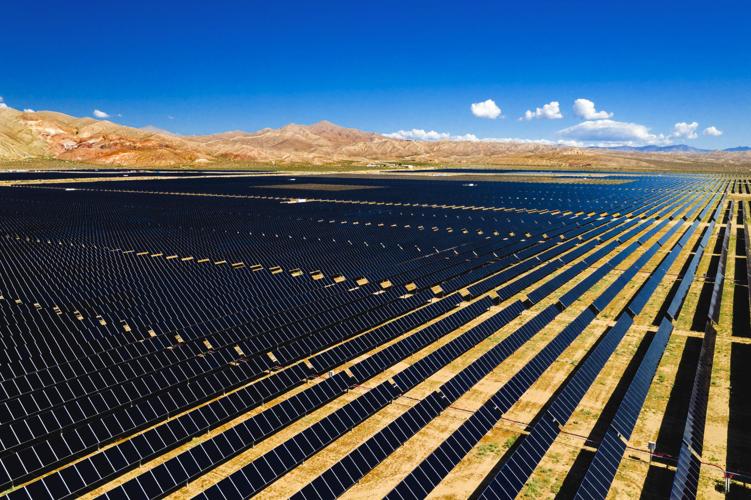China’s MASSIVE Desert Project Is About To Change The World

This is the biggest solar plant in the United States, located in Kern, California. The Solar Star Plant is over 8 square miles and has a generation capacity of 579 megawatts, powering around 255,000 homes. This is impressive, but about 6,500 miles away, in this remote desert, there’s a solar facility that could dwarf it … and just about every other solar plant on earth and it’s not alone. Like many deserts, China’s Kubuqi desert enjoys persistent but predictable winds and around 280 days of scorching sunshine every year. This makes it a challenging place to live, farm or do just about anything else, but it makes it perfect for solar and wind generation.
That’s exactly what China is doing.
This is the Kubuqi Renewables Base. It’s roughly the size of 20 Central Parks, and when fully operational, it will supply 16 gigawatts to well over a million homes. Kubuqi is impressive, but it’s just the center piece in a vast network of around 225 bases being built across China’s western and northern deserts. Kubuqi and its sister projects are well on track to have a generational capacity of 455 gigawatts(GW), 60% of which will be solar and the other 40% will be wind. That’s staggering to put it into perspective, that’s more clean energy generation capacity than is currently available in any nation outside China. 455 GW is equal to the combined green energy generation of the the United Kingdom, Australia and Indonesia, plus the total power capacity of Brazil. These bases are all due to come online within the next year or two. That means China could dwarf the world’s current renewable generation capabilities.
How has the world’s current biggest polluter turned into green energy’s biggest champion?
You probably already know that deserts are great for renewable energy generation. Can’t have a solar farm without sun and deserts have a lot of sun. Likewise wind farms need wind, and the broad, warm, flat expanses of desert make for reliable wind currents and predictable power generation. That all makes sense, but I’ve been a little deceptive. I haven’t shown you a single shot of the Kubuqi desert just now. These are from the Ulan Buh, Tengger, and Badain Jaran deserts, which are all also in China. It just so happens that over a fifth of China’s landmass is desert, and it’s one of the largest countries in the world. What I’m trying to say is China has a lot of room to work with, and as we mentioned earlier, deserts aren’t exactly valuable territory. So, the nation has leveraged the cheap real estate and surplus of sand to acquire huge tracts of land that it’s actively turning into these massive renewable bases. This helps drive down the price of solar and wind power. China has the resources and space to build a lot of cheap solar and wind energy, but there’s a more obvious factor at play here too. Back in the 90’s, China saw a financial opportunity in serving Germany’s growing demand for solar panels. Thanks to nearby raw materials and the structure of its supply chain, China was able to produce a ton of affordable solar panels. Other solar companies around the world didn’t like the government subsidies and incentives the Chinese government was leveraging. In response, many countries imposed tariffs on Chinese-made solar panels in the 2000s. However, China was able to pivot and grow its own domestic renewables program. This drove domestic demand for solar panels and turbines. As Chinese economic and industrial power grew, demand for renewables grew right alongside it.
how did China build their renewable energy bases:
Cheap access to a lot of green technology, lots of manufacturing power, and lots of land ideal for solar and wind generation. But how China is these bases isn’t as interesting as why China is rapidly building these bases. This is a big reason why China is going so big on renewables. This is Beijing in 2021, one of the biggest cities in one of the most powerful countries on Earth and it’s facing a crippling blackout. And this wasn’t the only blackout. What was that? That year the world faced a coal shortage due in part to the ongoing pandemic. More than half of China’s energy comes from coal, which meant that the shortage forced parts of China to go dark. Droughts also meant hydroelectric plants were struggling to keep up with demand. As you can imagine, that was bad for both Chinese citizens and the country’s economy at large. It’s just covered in a thick, toxic cloud. Industry isn’t clean. It needs a lot of power and the fastest and easiest way to get power is the Dark Side (I mean fossil fuels). And if China’s massive industrial sector wasn’t power-hungry enough, they also have a massive population that needs electricity too. Most of which, again, comes from fossil fuels, which results in pollution like this. Not the kind of imagery an ascendant global power wants to project.
Second largest consumer of oil
While we’re on the subject of fossil fuels, China is the world’s second-largest consumer of oil. They burned through over 13 million barrels per day in 2023, while only producing around 4 million. Including strategic reserves, this had led China to import around 11.4 million barrels of oil per day in 2023, which comes with a hefty price tag. Sure would be great if they weren’t reliant on others for their energy needs.
So why is China adding 455 GW of renewable energy?
Lots of economic reasons, protecting the health of their citizens, energy independence, and international prestige to name a few. Gosh, it’s almost like there’s just a lot of benefits to going green. And if it’s possible for this massive polluter to turn around, can other countries do it too? Are there lessons we can learn from China? And what does such a massive jump in green energy generation mean for the rest of the world?
Centre for Research on Energy and Clean
The installation of bases like the one in Kubuqi has analysts, like those from the Centre for Research on Energy and Clean Air (CREA), all but guaranteeing that Chinese emissions and fossil fuel use will not only fall next year, but enter “into an extended period of structural decline.” This is due not just to these bases coming online, but the growth of other greentech industries in China, like renewable batteries and electric vehicles. China is now hitting their 2030 reduced emissions goal five years ahead of schedule. This gives me hope that they’ll be able to hit their zero-emissions goal in 2060 as well. If one of the largest consumers of fossil fuels can do it, then the rest of us can too, right? More immediately, all these plants coming online should mean less polluted air not just for China, but its neighboring countries and may be more. If China continues to build these facilities, and the technology continues to improve, there are opportunities for these neighbours to buy surplus clean energy from China. Countries like Mongolia that are currently China’s major coal sources are acutely aware of China’s greenification. They’re trying to find alternative ways to generate energy and income as coal demand collapses. Mongolia shares the Gobi desert with China and their side of the Gobi is just as capable of generating that amazing solar and wind energy. There’s an opportunity here for China to export not just the energy, but the energy generation expertise and material to these neighbours. It’s flipping the script but these opportunities aren’t just limited to China’s neighbours.
Belt and Road Initiative
Since 2013, China has been making economic and literal in roads to much of the world (especially the global south) with its Belt & Road Initiative (BRI). It’s like China’s attempt to make a sort of neo-Silk Road.’ Basically, China builds up these countries’ infrastructure in exchange for favorable access to their natural resources. Under the BRI, China can potentially build up the green infrastructure of these countries too. Though I have to point out that the BRI is controversial. Proponents and the World Bank have noted that BRI involvement can raise a country’s GDP by upwards of 4%. It can also boost the world’s economy and gives these countries access to infrastructure development that, in many cases, wouldn’t normally be available to them. Detractors have called it a form of neocolonialism, and have cited instances where the program negatively impacted the local environment, involved displacing native peoples, and even some really bad human rights abuses.
Is that trade worth it for improved infrastructure and access to green technology
It’s a complicated issue, and it’s not really for me to decide. All of this assumes that what China is doing at home is replicable elsewhere, which is certainly not always going to be the case. Heck, even China is facing some serious problems. Check this out. Notice an issue? How about now? Most of the renewable bases are in those far less populated regions in the west while some of China’s biggest cities are on the east coast. It’s difficult to get all that power from point A to a very distant point B without losing a lot in the process. China is actively tackling this issue by developing ultra high voltage power lines. However, for the time being they’re actually generating more renewable energy than they can use, which is leading to curtailment. All the clean energy generation in the world doesn’t mean much if it’s not actually replacing fossil fuels.
Inflation Reduction Act
United States recently passed the Inflation Reduction Act (IRA), which directs $500 billion in federal spending and tax breaks toward, unsurprisingly, reducing inflation. Over half of that allotment is intended to go toward clean energy with another nearly $50 billion going toward manufacturing. Though no one can really match China’s manufacturing power, we are not too far behind here in the US. Our western and northern regions are home to deserts and grasslands ripe for solar and wind energy. We have our own installations in many of these places already, and I’m glad the IRA seems to have learned from China’s economic incentives, but I hope we go further, and create our own fully fledged clean energy bases. Having everything from mining resources to manufacturing solar panels, wind turbines, and batteries here in the US could drop costs and accelerate our adoption and give us a tremendous amount of energy security. No bones about it, this is an amazing step in the right direction. And unlike a lot of stuff in the green tech space, the Kubuqi clean energy base isn’t a work of futurology or the pitch of an exciting startup. It’s real, it’s working right now, and it’s getting bigger. It has a bunch of sibling bases all coming online in the next few years. China’s basically doubling the world’s renewable generation overnight? What’s not to like? Well, it’s not an unalloyed good or success. China’s emissions levels have continued to rise, and they’re still building coal plants to supplement the intermittent power of their renewable bases.
After a post COVID rebound in CO2 output during 2023, some estimates are showing that China may have hit peak carbon 2024 and beyond shows declining numbers but building and permitting more coal plants in 2023 and beyond feels like two steps forward and one step back. As we’ve seen in places like Germany, even methodical, well-planned attempts to entirely phase out coal by 2030 have been scrapped in light of unforeseen geopolitics and energy crises. China already accounts for half the world’s coal consumption, so it’s worrying to see their government constructing even more coal plants. As some analysts have warned, there’s a fight brewing in China between renewables stakeholders, and fossil fuels stakeholders. It’s a familiar fight we’re seeing everywhere around the world.






